George Vivian (artist)
George Vivian (1798–1873)[1] was an English traveller and topographical artist. He is known for Spanish landscapes and views from Italian gardens.[2]
Life
He was the second son of John Vivian, a solicitor of the excise, and barrister, the second son of Matthew Vivian of Penelewey, near Truro.[1][3] He was educated at Eton College, and matriculated at Christ Church, Oxford in 1817.[4]
Vivian made early travels to Vienna and the Balkans in 1818, and Albania in 1819 (when he met Ali Pasha of Ioánnina (1740-1822)). During a journey of 1824 to the Near East he encountered Lord Byron.[5] In 1828, on the death of his father, he inherited Claverton Manor.[1] He joined the Travellers Club in 1828 or 1829.[6] He made further journeys, to Spain and Portugal, in 1831 and 1837.[5]
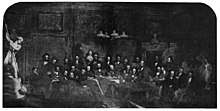
Vivian was a commissioner for the plans to rebuild the Houses of Parliament in 1835, and became a member of the Society of Dilettanti in 1837.[7][8] In the period before his marriage, he visited Germany, Scandinavia and Russia.[5] He studied monumental art in Munich.[9] He sat on the Fine Arts Commission from 1841 to 1863, the whole period of its existence.[10] The Commission arose from an initial proposal and Select Committee of Benjamin Hawes, to couple the rebuilding of the Houses of Parliament with a national promotion of the fine arts. Vivian had shown that committee arabesques from the Palazzo del Te. In a group of 22 dominated by noblemen, patrons and politicians, Vivian represented connoisseurs and collectors, with Samuel Rogers and Thomas Wyse.[11][12]
Contracting malaria in the Campagna in 1846, Vivian never again enjoyed perfect health.[5] He died on 5 January 1873, at 11 Grosvenor Square, London and was buried in Brompton Cemetery.[13] His library was put up for sale in 1875.[14]
Works
Vivian published illustrated books, mostly based on his own drawings.
- Some Illustrations of the Architecture of Claverton and of the Duke's House, Bradford, etc. (1837).[13] The plates were lithographs by Vivian, mostly from architectural drawings by Charles James Richardson (but Richardson was only 14 years old when the Old Manor was destroyed and George Vivian is likely to have made the drawings).[5] Richardson's Observations on the architecture of England during the reigns of Queen Elizabeth and King James I of the same year is a related work having plates in common, dedicated to Vivian, and published by John Weale.[15][16]
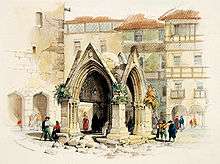
- Spanish Scenery (1838), lithographs by Louis Haghe and others.[17]
- Scenery of Portugal and Spain (1839), lithographs by Louis Haghe, William Day and others.[13][18]
- Views from the Gardens of Rome and Albano (1848), engravings by James Duffield Harding.[13]
Harding was a friend, and is considered to have influenced Vivian's style.[5]
Vivian wrote articles on architecture for the Quarterly Review.[19] John Britton commented favourably in 1840 on his anonymous pamphlet The Prospects of Art in the Future Parliament House from 1835, which presaged the Fine Arts Commission.[20][21]
Claverton Manor and the Vivians
John Vivian, father of George, purchased Claverton Manor in 1816;[1] he brought in Jeffry Wyatt before 1820 for a new design. Wyatt persuaded John Vivian to rebuild Claverton Manor.[22]
John Vivian
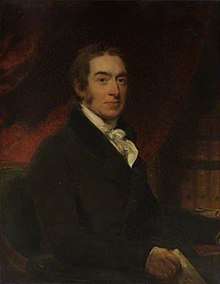
John Vivian (1756–1828), from a Cornish background, matriculated at St Mary Hall, Oxford in 1779, at age 22, graduating M.A. in 1784. He was called to the bar at the Inner Temple in 1785, the same year becoming solicitor to the Excise at Bristol, and later being made a bencher of the Middle Temple.[23][24] (A correction to Bibliotheca Cornubiensis differentiates the Excise solicitor John Vivian from John Vivian of the Inner Temple; but that distinction is contradicted by the website of the American Museum and Gardens, located in Claverton Manor.[1][25])
He married Marianne Edwards in 1792, and had a son John Edwards Vivian (born 1795/6) who was called to the bar at the Middle Temple in 1815. She was the daughter and heiress of Samuel Edwards of Cotham Lodge, in Gloucestershire near Bristol, who died in 1815.[24][26][27][28]
The Alumni Oxonienses record for George Vivian gives, for 1817, his father's residence as "Colham, Gloucestershire". This presumably means "Cotham".[4] Marianne Vivian died in Portland Place, London in 1826, and John died there in 1828, aged 73.[29][30]
The two houses at Claverton
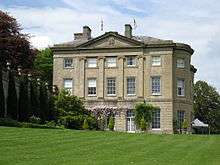
The new Manor commissioned by John Vivian was on a fresh site, some 400 metres (1,300 ft) away from the old house, which was demolished, and in a neo-classical style, built from Bath stone.[31] George Vivian, in contrast, undertook to preserve what he could of the old house, completed in 1625.[5][31]
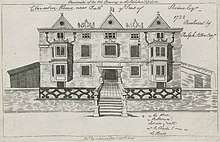
The old Manor became a noted example of Jacobean architecture, documented in some of its details by Richardson's 1837 book on the period. The architect Alexander Roos came to know Vivian by the early 1840s.[32]
George Vivian as collector
Vivian added a gallery in the south wing of Claverton Manor, to display his art collection.[1] He was a significant collector, owning in particular The Introduction of the Cult of Cybele at Rome by Andrea Mantegna, now in the National Gallery, London. He acquired it from the Venetian dealer Antonio Sanquirico.[33][34] Under the original title Triumph of Scipio, it was exhibited several times.[35][36] A supposed portrait of Michelangelo by Andrea del Sarto was later exhibited by his son, around 1880, as by Sebastiano del Piombo, based on an attribution by Bernard Berenson.[37][38] It went to the Isabella Stewart Gardner Museum in 1899, was attributed there to Baccio Bandinelli, and is now taken to be a self-portrait of his.[39][40]
Later history
In 1855 Vivian let Claverton Manor to James Wilson. The house was sold in 1869, to Isaac Carr, agent. It was bought in 1874 by Henry Duncan Skrine (1815–1901).[1][41] This was full circle in family terms, Ralph Allen having bought it in 1758 from William Skrine, and Allen's great-nephew Allen Tucker having sold it to John Vivian.[42]
Family
Vivian married in 1842 Elizabeth Anne Grey, eldest daughter of Ralph William Grey (died 1822) of Backworth House, and sister of Ralph William Grey (1819–1869) the Member of Parliament.[43][44][45][46] The Greys of Backworth, in the Tynemouth area, owned coal rights, and were bought out by Hugh Percy, 2nd Duke of Northumberland.[47] The Grey family resided in Weymouth Street off Portland Place in London, in 1809.[48]
The couple lived in Italy from 1844 to 1846, and their only son Ralph, who became an army officer, was born there.[44] Their daughter Minna Frances married in 1888 the Revd Vivian Eccles Skrine.[49][50] Their other daughter, Alice Jane, died unmarried in 1921.[49] Charles George Vivian, son of Vivian's younger brother the Revd Charles Pasley Vivian who died in 1841, entered Rugby School in 1847 as Vivian's ward.[51][52]

Ralph Vivian (1845–1924) served in the Scots Guards in the British Conquest of Egypt (1882).[53] He retired from the Army in 1883, and became a director of the machine tool company Greenwood & Batley in 1888.[54] In 1892 he married Susan Lawrence née Endicott, widow of Marshall Owen Roberts.[49]
Notes
| Wikimedia Commons has media related to George Vivian. |
- "The American Museum in BritainThe History of Claverton Manor". American Museum & Gardens.
- "Vivian, George". Benezit Dictionary of Artists. doi:10.1093/benz/9780199773787.001.0001/acref-9780199773787-e-00192085.
- Somersetshire Archaeological and Natural History Society (1934). Proceedings. 79-80. Barnicott and Pearce. p. 70.
- Foster, Joseph (1888–1892). . Alumni Oxonienses: the Members of the University of Oxford, 1715–1886. Oxford: Parker and Co – via Wikisource.
- H. L. Mallalieu (1986). The Dictionary of British Watercolour Artists up to 1920. Antique Collectors' Club. p. 265. ISBN 1-85149-025-6.
- Oriental Translation Fund (1829). Report of the proceedings of the ... general meeting of the subscribers to the Oriental Translation Fund. p. 19.
- W. J. Rorabaugh, Politics and the Architectural Competition for the Houses of Parliament, 1834–1837, Victorian Studies Vol. 17, No. 2 (Dec., 1973), pp. 155–175, at pp. 164–167. Published by: Indiana University Press JSTOR 3826182
- Cust, Lionel; Colvin, Sidney (1898). History of the Society of Dilettanti. London : MacMillan. p. 4.
- Willsdon, Clare A. P. (2000). Mural Painting in Britain 1840-1940: Image and Meaning. Oxford University Press. p. 46. ISBN 978-0-19-817515-5.
- Colvin, Howard (editor) (1963). The History of the King's Works: 1782-1851, by J.M. Crook and M.H. Port. VI. H.M. Stationery Office. p. 576.CS1 maint: extra text: authors list (link)
- Martin, Eoin (2013). "Queen Victoria, Prince Albert and the Patronage of Contemporary Sculpture in Victorian Britain 1837-1901" (PDF). wrap.warwick.ac.uk. pp. 68–71.
- Boase, T. S. R. (1954). "The Decoration of the New Palace of Westminster, 1841-1863". Journal of the Warburg and Courtauld Institutes. 17 (3/4): 322. doi:10.2307/750325. JSTOR 750325.
- Boase, George Clement (1878). Bibliotheca Cornubiensis: P-Z. Longmans, Green, Reader and Dyer. pp. 829–830.
- The Athenæum. 1875. p. 106.
- "Observations on the architecture of England during the reigns of Queen Elizabeth and King James I. &c. &c. Books, RA Collection, Royal Academy of Arts". www.royalacademy.org.uk.
- The Wiltshire Archaeological and Natural History Magazine. The Society. 1854. p. 267.
- Speake, Jennifer (2003). Literature of Travel and Exploration: R to Z, index. Taylor & Francis. p. 1024. ISBN 978-1-57958-440-5.
- Press, Oxford University (2012). Benezit Dictionary of British Graphic Artists and Illustrators. OUP USA. p. 323. ISBN 978-0-19-992305-2.
- R. J. B. Walker, The Palace of Westminster after the Fire of 1834, The Volume of the Walpole Society Vol. 44 (1972–1974), pp. 94–122, at p. 103. Published by: The Walpole Society JSTOR 41829434
- Britton, John (1840). Graphic illustrations, with historical and descriptive accounts, of Toddington, Gloucestershire, the seat of Lord Sudeley. The Author. p. xv.
- A Catalogue of the Library of the Athenæum. members. 1845. p. 477.
- Howard Colvin (1978). A Biographical Dictionary of British Architects 1600–1840. John Murray. p. 962. ISBN 0 7195 3328 7.
- Foster, Joseph (1888–1892). . Alumni Oxonienses: the Members of the University of Oxford, 1715–1886. Oxford: Parker and Co – via Wikisource.
- Boase, George Clement (1878). Bibliotheca Cornubiensis: P-Z. Longmans, Green, Reader and Dyer. p. 831.
- Boase, George Clement; Courtney, William Prideaux (1874). Bibliotheca cornubiensis. A catalogue of the writings, both manuscript and printed, of Cornishmen, and of works relating to the county of Cornwall, with biographical memoranda and copious literary references. II. London : Longmans, Green, Reader and Dyer. pp. Corrigenda and Addenda viii, and pp.829-830.
- "Vivian, John Edwards (VVN815JE)". A Cambridge Alumni Database. University of Cambridge.
- Lords, Great Britain House of (1820). Journals of the House of Lords. H.M. Stationery Office.
- New Monthly Magazine. Henry Colburn. 1815. p. 179.
- The Gentleman's Magazine (London, England). F. Jefferies. 1826. p. 187.
- The Gentleman's Magazine, and Historical Chronicle. E. Cave. 1828. p. 92.
- Historic England. "Details from listed building database (1000564)". National Heritage List for England.
- Bradney, Caroline Jane (2008). "The Italian Garden in England 1787-1863, volume 1" (PDF). research-information.bris.ac.uk. p. 266.
- "Mantegna Andrea - Cibele, L'introduzione del culto di Cibele a Roma". arte.cini.it.
- Pemble, John (1995). Venice Rediscovered. Clarendon Press. p. 126.
- Cartwright, Julia (1881). Mantegna and Francia. London, S. Low, Marston, Searle, & Rivington. pp. 148–149.
- Mantegna, Andrea; Russell, Peter (2020). Delphi Complete Paintings of Andrea Mantegna (Illustrated). Delphi Classics. p. 506. ISBN 978-1-913487-14-0.
- Museum, Isabella Stewart Gardner; Hendy, Sir Philip (1974). European and American Paintings in the Isabella Stewart Gardner Museum. Trustees of the Isabella Stewart Gardner Museum. p. 12. ISBN 978-0-914660-00-2.
- Emison, Patricia A. (2004). Creating the "Divine" Artist: From Dante to Michelangelo. Brill. p. 221 note 4. ISBN 978-90-04-13709-7.
- Loh, Maria H. (2015). Still Lives: Death, Desire, and the Portrait of the Old Master. Princeton University Press. p. 253 note 37. ISBN 978-0-691-16496-0.
- "Self-Portrait, Isabella Stewart Gardner Museum". www.gardnermuseum.org.
- Wrigley, Chris (2002). Winston Churchill: A Biographical Companion. ABC-CLIO. p. 131. ISBN 978-0-87436-990-8.
- Tunstall, James (1876). Rambles about Bath and Its Neighbourhood. Simpkin, Marshall, and Company. p. 87.
- The Gentleman's Magazine. A. Dodd and A. Smith. 1842. p. 92.
- The Connoisseur: An Illustrated Magazine for Collectors. Sampson Low, Marston & Company. 1935. p. 30.
- "Grey, Ralph William (GRY798RW)". A Cambridge Alumni Database. University of Cambridge.
- "Grey, Ralph William (GRY836RW)". A Cambridge Alumni Database. University of Cambridge.
- Men of Mark 'twixt Tyne and Tweed. Walter Scott. 1895. pp. 381–382.
- The Rugby Register, from the year 1675 to the present time. Rugby, T. Combe. 1838. p. 140.
- Burke, Bernard (1939). Burke's Genealogical and Heraldic History of the Landed Gentry: Including American Families with British Ancestry. Burke's Peerage, Ltd. p. 1665.
- Fox-Davies, Arthur Charles (1930). Armorial Families. 2 (7th ed.). London: Hurst & Blackett. p. 2011.
- Michell, Arthur Tompson (1902). Rugby School Register. II. Rugby: A. J. Lawrence. p. 66.
- Foster, Joseph (1888–1892). . Alumni Oxonienses: the Members of the University of Oxford, 1715–1886. Oxford: Parker and Co – via Wikisource.
- S. G. P. Ward, The Scots Guards in Egypt, 1882: The Letters of Lieutenant C. B. Balfour, Journal of the Society for Army Historical Research Vol. 51, No. 206 (Summer 1973), pp. 80–104, at p. 89 note 20. Published by: Society for Army Historical Research JSTOR 44227018
- Floud, Roderick. The British Machine Tool Industry, 1850-1914. 1976: Cambridge University Press. p. 121.CS1 maint: location (link)